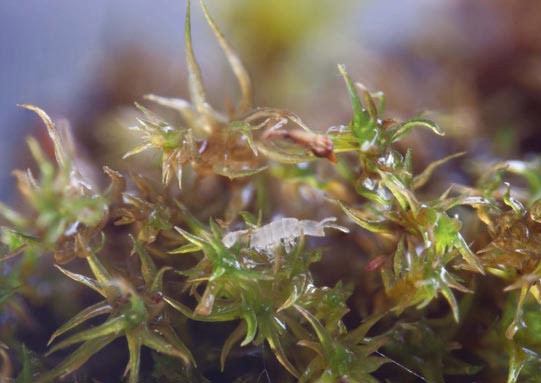A common species of moss (Ceratodon purpureus) that lives in weedy and forested habitats has been found to use an unusual strategy to reproduce: it produces a chemical scent to recruit tiny arthropods like mites and springtails to transport sperm from male to female mosses. The process, somewhat like flowers being pollinated by bees, seems to work best in moist and rainy environments.
“Most mosses have plants of separate sexes, and it was assumed that the sperm would swim from male to female,” explained Sarah Eppley, a researcher at Portland State University in Oregon and the lead author on a study published last summer in the journal Nature. “But because the plants can be meters away, we were pretty sure that they couldn’t swim the whole way. Rainwater can probably wash it from one plant to another, but there must be some other mechanism because the sperm don’t have the ability to swim very far.”
In an initial laboratory study, Eppley found that sexual reproduction could occur by adding only rainwater to the moss or by adding only springtails, but fertilization occurred at twice the rate when both were added to the moss. “There appeared to be a synergistic effect,” Eppley said. “Rainwater plus arthropods gives twice as much sexual reproduction.”
The springtails, sometimes called snow fleas, live on the forest floor and consume rotting tree litter and fungi. Eppley said that in the Pacific Northwest, where her study was conducted, there are about 300,000 springtails per square meter of forest.
Using a highly sensitive olfactory meter, Eppley then found that the cue that was attracting the arthropods to the mosses was a chemical scent produced almost exclusively by female mosses. By placing male and female mosses in separate chambers in which the arthropods could smell but not see or touch them, the springtails were primarily attracted to the chambers holding female mosses.
“There is something about the females’ scent that the springtails really like,” Eppley said. “We believe that the sperm get released by the male and move all around the moss by swimming in the water film.”
But how does that sperm make its way to female mosses?
“Our idea is that the arthropods dip their legs in the sperm and carry it with them, and the scent [of female mosses] draws them to those female reproductive structures.”
What the springtails get from this relationship is uncertain. Perhaps there are sugars produced by the moss reproductive structures that it can feed upon. Or maybe the moss scent also recruits fungus that the springtails eat.
Eppley and her research team plan to continue this research to learn at what stage of development the mosses produce the scent and to examine other moss species to see how broadly this strategy is employed.


